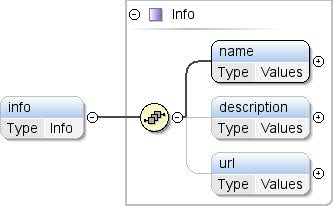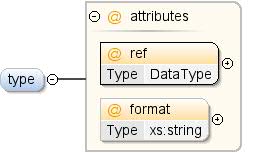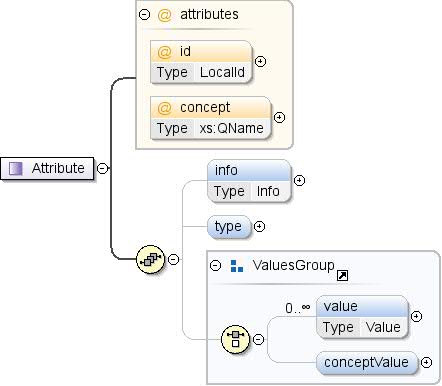Składnik: atrybut
Zadbaj o dobrą organizację dzięki kolekcji
Zapisuj i kategoryzuj treści zgodnie ze swoimi preferencjami.
Element: Atrybut / informacje
| Przestrzeń nazw |
http://schemas.google.com/dspl/2010 |
| Adnotacje |
Informacje tekstowe na temat atrybutu. |
| Diagram |
 |
| Typ |
Informacje |
| Właściwości |
|
| Model |
name , description{0,1} , url{0,1} |
| Dzieci |
description, name, url |
| Instancja |
<info>
<name>{1,1}</name>
<description>{0,1}</description>
<url>{0,1}</url>
</info>
|
| Źródło |
<xs:element name="info" type="Info" minOccurs="0">
<xs:annotation>
<xs:documentation>Textual information about the attribute.</xs:documentation>
</xs:annotation>
</xs:element>
|
Element: Atrybut / typ
| Przestrzeń nazw |
http://schemas.google.com/dspl/2010 |
| Adnotacje |
Typ danych atrybutu. |
| Diagram |
 |
| Właściwości |
|
| Atrybuty |
| QName |
Typ |
Naprawiono |
Domyślny |
Użyj |
Adnotacja |
| format |
xs:string |
|
|
opcjonalnie |
Format wartości używany do analizowania tekstu
ich reprezentację. Zajrzyj do [specyfikacji formatów dat], aby dowiedzieć się więcej.
daty. |
| źródło |
DataType |
|
|
wymagane |
|
|
| Źródło |
<xs:element name="type" minOccurs="0">
<xs:annotation>
<xs:documentation>The data type of the attribute.</xs:documentation>
</xs:annotation>
<xs:complexType>
<xs:attribute name="ref" type="DataType" use="required"/>
<xs:attribute name="format" type="xs:string" use="optional">
<xs:annotation>
<xs:documentation>A format for the value, used to parse a textual
representation of the values. See [Date formats spec]
for dates.</xs:documentation>
</xs:annotation>
</xs:attribute>
</xs:complexType>
</xs:element>
|
Typ złożony: atrybut
| Przestrzeń nazw |
http://schemas.google.com/dspl/2010 |
| Adnotacje |
Atrybut zbioru danych lub koncepcji. |
| Diagram |
 |
| Używane przez |
|
| Model |
info{0,1} , type{0,1} , (wartość*
| conceptValue{0,1}) |
| Dzieci |
conceptValue, info, type,
wartość |
| Atrybuty |
| QName |
Typ |
Naprawiono |
Domyślny |
Użyj |
Adnotacja |
| koncepcja |
xs:QName |
|
|
opcjonalnie |
Odniesienie do pojęcia, który odpowiada wartościom.
atrybutu. Jeśli atrybut określa typ, to
musi pasować do typu wskazanej koncepcji. Odwołanie do
koncepcja zewnętrzna musi mieć postać
„prefix:other_koncepcja”, gdzie „prefiks” to
prefiks używany dla przestrzeni nazw zewnętrznego zbioru danych (patrz XML
przestrzeni nazw). |
| id |
LocalId |
|
|
opcjonalnie |
Identyfikator atrybutu koncepcja. Ten identyfikator musi być:
które są unikalne (w odniesieniu do różnych atrybutów i właściwości).
„id” można pominąć, jeśli określono atrybut „koncepcja”. Pod tym kątem
, identyfikator to prostota, którą określa się z wartością lokalną
wymienionego pojęcia. Na przykład <atrybut
concept="unit:currency"/> jest odpowiednikiem funkcji
<attribute id="currency"
concept="unit:currency"/> |
|
| Źródło |
<xs:complexType name="Attribute">
<xs:annotation>
<xs:documentation>An attribute of a dataset or a concept.</xs:documentation>
</xs:annotation>
<xs:sequence>
<xs:element name="info" type="Info" minOccurs="0">
<xs:annotation>
<xs:documentation>Textual information about the attribute.</xs:documentation>
</xs:annotation>
</xs:element>
<xs:element name="type" minOccurs="0">
<xs:annotation>
<xs:documentation>The data type of the attribute.</xs:documentation>
</xs:annotation>
<xs:complexType>
<xs:attribute name="ref" type="DataType" use="required"/>
<xs:attribute name="format" type="xs:string" use="optional">
<xs:annotation>
<xs:documentation>A format for the value, used to parse a textual
representation of the values. See [Date formats spec]
for dates.</xs:documentation>
</xs:annotation>
</xs:attribute>
</xs:complexType>
</xs:element>
<xs:group ref="ValuesGroup" minOccurs="0"/>
</xs:sequence>
<xs:attribute name="id" type="LocalId" use="optional">
<xs:annotation>
<xs:documentation>The id of the concept attribute. This identifier must be unique within the concept
(across attributes and properties).
The id may be omitted if the concept attribute is specified. In that case, an id is
implicity created with value the local name of the referenced concept. For instance
<attribute concept="unit:currency"/>
is equivalent to
<attribute id="currency" concept="unit:currency"/></xs:documentation>
</xs:annotation>
</xs:attribute>
<xs:attribute name="concept" type="xs:QName" use="optional">
<xs:annotation>
<xs:documentation>A reference to a concept that corresponds to the values of the attribute.
If the attribute specifies a type, then the type must match the type of
the referenced concept.
A reference to an external concept must be of the form "prefix:other_concept_id",
where "prefix" is the prefix used for the namespace of the external dataset
(see XML namespaces).</xs:documentation>
</xs:annotation>
</xs:attribute>
</xs:complexType>
|
| Przestrzeń nazw |
Brak przestrzeni nazw |
| Typ |
DataType |
| Właściwości |
|
| Aspekty |
| wyliczenie |
ciąg znaków |
|
| wyliczenie |
liczba zmiennoprzecinkowa |
|
| wyliczenie |
liczba całkowita |
|
| wyliczenie |
wartość logiczna |
|
| wyliczenie |
data |
|
| wyliczenie |
pomysł : koncepcja |
|
|
| Używane przez |
|
| Źródło |
<xs:attribute name="ref" type="DataType" use="required"/>
|
| Przestrzeń nazw |
Brak przestrzeni nazw |
| Adnotacje |
Format wartości używany do analizowania składni tekstowej
tych wartości. Zajrzyj do [specyfikacji formatów dat], aby zapoznać się z datami. |
| Typ |
xs:string |
| Właściwości |
|
| Używane przez |
|
| Źródło |
<xs:attribute name="format" type="xs:string" use="optional">
<xs:annotation>
<xs:documentation>A format for the value, used to parse a textual
representation of the values. See [Date formats spec]
for dates.</xs:documentation>
</xs:annotation>
</xs:attribute>
|
Atrybut: Attribute (Atrybut) / @id
| Przestrzeń nazw |
Brak przestrzeni nazw |
| Adnotacje |
Identyfikator atrybutu koncepcja. Ten identyfikator musi być unikalny
(w odniesieniu do różnych atrybutów i właściwości). Identyfikatorem może być
jest pomijany, jeśli określono atrybut Concept. W takim przypadku identyfikator to
prostota utworzona z wartością lokalną nazwę wskazanej koncepcji.
Na przykład <attribute Concept="unit:currency"/> to
odpowiednik <attribute id="currency"
concept="unit:currency"/> |
| Typ |
LocalId |
| Właściwości |
|
| Aspekty |
|
| Używane przez |
|
| Źródło |
<xs:attribute name="id" type="LocalId" use="optional">
<xs:annotation>
<xs:documentation>The id of the concept attribute. This identifier must be unique within the concept
(across attributes and properties).
The id may be omitted if the concept attribute is specified. In that case, an id is
implicity created with value the local name of the referenced concept. For instance
<attribute concept="unit:currency"/>
is equivalent to
<attribute id="currency" concept="unit:currency"/></xs:documentation>
</xs:annotation>
</xs:attribute>
|
Atrybut: Atrybut / @Concept
| Przestrzeń nazw |
Brak przestrzeni nazw |
| Adnotacje |
Odniesienie do pojęcia, który odpowiada wartościom atrybutu
. Jeśli atrybut określa typ, to typ musi być zgodny
typ wspomnianego pojęcia. Odniesienie do koncepcji zewnętrznej
musi mieć format „prefix:identyfikator_innego_koncepcji”, gdzie
„prefiks” to prefiks używany dla przestrzeni nazw zewnętrznego
zbiór danych (patrz przestrzenie nazw XML). |
| Typ |
xs:QName |
| Właściwości |
|
| Używane przez |
|
| Źródło |
<xs:attribute name="concept" type="xs:QName" use="optional">
<xs:annotation>
<xs:documentation>A reference to a concept that corresponds to the values of the attribute.
If the attribute specifies a type, then the type must match the type of
the referenced concept.
A reference to an external concept must be of the form "prefix:other_concept_id",
where "prefix" is the prefix used for the namespace of the external dataset
(see XML namespaces).</xs:documentation>
</xs:annotation>
</xs:attribute>
|
Utworzono za pomocą
oXygen XML Editor.
O ile nie stwierdzono inaczej, treść tej strony jest objęta licencją Creative Commons – uznanie autorstwa 4.0, a fragmenty kodu są dostępne na licencji Apache 2.0. Szczegółowe informacje na ten temat zawierają zasady dotyczące witryny Google Developers. Java jest zastrzeżonym znakiem towarowym firmy Oracle i jej podmiotów stowarzyszonych.
Ostatnia aktualizacja: 2025-07-25 UTC.
[[["Łatwo zrozumieć","easyToUnderstand","thumb-up"],["Rozwiązało to mój problem","solvedMyProblem","thumb-up"],["Inne","otherUp","thumb-up"]],[["Brak potrzebnych mi informacji","missingTheInformationINeed","thumb-down"],["Zbyt skomplikowane / zbyt wiele czynności do wykonania","tooComplicatedTooManySteps","thumb-down"],["Nieaktualne treści","outOfDate","thumb-down"],["Problem z tłumaczeniem","translationIssue","thumb-down"],["Problem z przykładami/kodem","samplesCodeIssue","thumb-down"],["Inne","otherDown","thumb-down"]],["Ostatnia aktualizacja: 2025-07-25 UTC."],[],["The core content describes the structure and properties of an \"Attribute\" within a dataset or concept. An attribute can include optional textual information (`info`), its data `type` (required), and value. The `type` specifies the data type and can have a `format`. Attributes have an optional `id` for unique identification and can refer to another `concept`. The `info` section may include name, description, and URL.\n"]]



